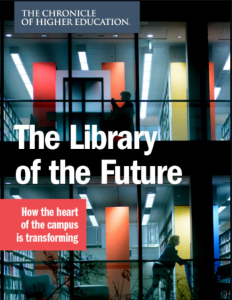CHE Publishes Report on Academic Libraries
 Today is Dr. Frank Einhellig’s final day at MSU following his long, dedicated, successful service to MSU and higher education as an academic researcher, teacher, author, dean of the graduate school, and provost. We all thank him and wish him the best in his well-earned retirement.
Today is Dr. Frank Einhellig’s final day at MSU following his long, dedicated, successful service to MSU and higher education as an academic researcher, teacher, author, dean of the graduate school, and provost. We all thank him and wish him the best in his well-earned retirement.
In his final month at MSU, the Provost recommended that as many employees as possible read and reflect on a recent report published by the Chronicle of Higher Education (CHE): The Library of the Future: How the Heart of the Campus is Transforming, researched and written by Scott Carlson, and published earlier in 2022.
The MSU Libraries has acquired and cataloged a print copy of this report. A few of the many key ideas and recommendations in the report are:
- Rachel Ivy Clarke, an assistant professor in the School of Information Studies at Syracuse, notes, “Library ‘science’ may be a misnomer…. The job is really much more about creativity and flexibility (p. 41).”
- “Library and information schools, and the job market, are putting more priority on communication, public speaking, outreach, and teaching skills (p. 42).”
- “Library programs themselves have considered providing alternative ways to enter the field. Many institutions are considering micro-credentials in library skills and other kinds of paraprofessional training (p. 45).”
- “College leaders should consider how the library can support a range of activities related to student success and community building (p. 52).”
- Yale University is restructuring its Special Collections to provide the broadest possible access to special collections for patrons, and a frictionless experience for scholars (p. 37).
- The report recommends conducting a security audit to increase access and use of special collections.
- “Librarians who are doing essential work are not just helping scholars get access to data, but also helping them interpret it, or figure out how to combine that data with other related information (40).”